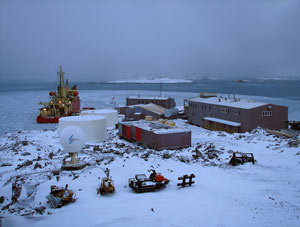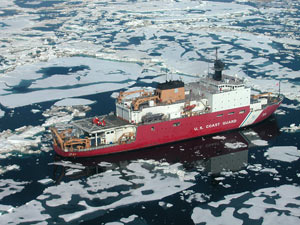Compare the Poles: Science

The icebreaker Laurence M. Gould at Palmer Station, one of three U.S. science stations on Antarctica. Palmer is home to about 45 researchers and support personnel during the austral summer. Photo by Janis Umschlag, WHOI.
Antarctica
Over 60 scientific bases have been established by 27 different nations in Antarctica. In summer, more than 4,000 scientists are there conducting experiments. This number decreases to 1,000 in the winter. McMurdo Station, run by the United States, is capable of housing more than 1,000 scientists, visitors, and tourists.
Researchers from a variety of disciplines study here, including biologists, geologists, oceanographers, physicists, astronomers, glaciologists, and meteorologists. Geologists study plate tectonics, meteorites from outer space, and resources from the breakup of the supercontinent Gondwanaland. Glaciologists study the history and dynamics of floating ice, seasonal snow, glaciers, and ice sheets. Biologists study adaptation and survival strategies in a wide variety of organisms. Medical physicians have made discoveries about the spread of viruses and the body's response to extreme temperatures.
Astrophysicists at the Amundsen-Scott South Pole Station are better able to study the stars and planets because of the dry, cloud-free environment. Antarctic ice serves as both the shield and the detection medium for the largest neutrino telescope in the world, built 2 km below Amundsen-Scott station.
Arctic

The US Coast Guard icebreaker Healy working in the pack ice off Alaska.

